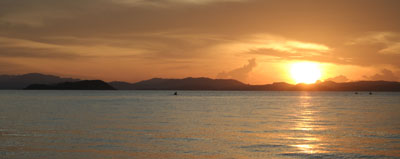
Conclusion
There are coral reef areas in the Anambas Islands that deserve protection,
especially given that they are still carrying scars from damage done to them
in the past (dynamite fishing and drag netting). There are some health and vitality
issues which, if exacerbated, could affect these reefs, in particular a presence
of crown of thorns and an incidence of coral disease (predominantly white band
disease). Both of these phenomena are currently not a severe threat to the health
and vitality of the reefs upon which they are found.
Limited time did not allow us to explore as much as we would have liked underwater but an overall impression was that the predatory fish population was low and that the vibrancy of the reef substrate was not reflected in the fish life swimming above it. Steven Tolam told us that one of the reasons we were seeing few large predatory fish was because it was NW monsoon season while we were there. This, plus the fact that the Anambas Islands are situated in the shallow South China Sea with no deep-water upwellings, are factors in the low sightings of pelagic fish. In terms of reef fish, the diversity is healthy. It is also possible that heavy fishing has taken place in this area in years past and that the predator populations have not yet recovered.
In general, it would appear that the health and vitality of the coral reefs of the Anambas Islands increase the further south, and therefore further away, one gets from the area of Siantan where Terempah, the town and population hub, is based. There was a marked difference between the health of the hard coral substrate already by the time we had traveled as far south as Dikar. By the time we reached Bawah, there was very little sign of coral suffering from disease or predation by crown of thorns. It is most likely that being closer to the centre of Terempah, the northern reefs have been more heavily fished in the past. The use of dynamite fishing which increases the nutrient level in the water column is very possibly a factor in the incidence of disease on the northern reefs (Semut, Penjalin, Berhala).
Trades and activities that have negative impacts on coral reef ecosystems are ubiquitous in South East Asia and the Anambas Islands have been no exception. We did not observe any dynamite fishing taking place, nor find any evidence of recent blasts underwater. However, small shark fins drying in the sun and a very young shark for sale in the fish market in Terempah were worrying sights
We sighted a reasonable number of turtles during our time here but only once met dolphins, two bottlenose dolphins, who surfaced once then swam away from SV Infinity under motor between Telibang and Bawah. Again, the shallow seas may not be enticing to a cetacean population.
It would be extremely rewarding to protect the Anambas Islands, especially to declare certain thriving reef areas (such as the channel between Penjalin Besar and Penjalin Kecil, or the reef tongue at Dikar) as no-fishing zones and to observe the changes in fish populations. It would appear that little scientific research has been conducted in the Anambas, either in the water or on the land, but already there are several endemic species known.

page1 page 2 page 3 page 4 page 5 page 6 page 7 conclusion